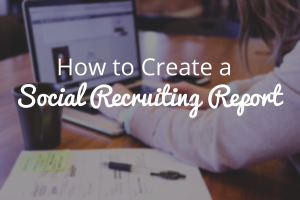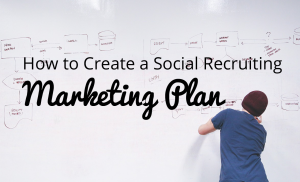69% of job seekers would not take a job at a company with a poor employer brand. (Source)
Millennials value a workplace culture-fit more than any generation before them.
And, every year, more candidates turn to social media to assess potential employers and to look for work.
Companies cannot reach today’s candidates without creating a strong, visible employer brand, engaging job seekers on social media, and selling the heck out of their culture.
In short, companies need to start marketing themselves to potential hires if they want to win the war for talent.
The key to marketing is connecting with your audience. To do this with job seekers, you will need to engage them on a personal level, at the right time, and with the right message.
In this article you’ll learn how to create a social recruiting marketing plan that will help you achieve that goal.
Step 1: Create a candidate persona
Before you can even begin to connect with your audience, you need to know who they are.
Do not confuse this step with knowing what you want in an employee!
Understanding your audience is not the same as knowing what qualifications or skills they should have on their resume.
In marketing, this is called creating a customer persona. For recruiting, we’ll just replace the word ‘customer’ with ‘candidate’.
Good marketers study their audience to learn their behaviors and understand their attitudes. They use this information to build comprehensive profiles that detail their customer’s wants, their everyday problems, and their needs.
To create a candidate persona ask yourself:
What is your candidate's goal?
What perks matter most to them?
What motivates them?
What social networks do they use?
Personally, I like to use a tool called personapp for this, but a pen and paper will work too!
Once you create your candidate persona for your ideal candidate, you can use it to target them with (recruitment) content marketing and your employer branding.
Which brings us to step 2…
Step 2: Perfect your employer brand
Your employer brand is vital for reaching candidates.
Investing in employer brand is shown to cut back employee turnover by a third. A robust employer brand can reduce cost per hire by 50%, and poor employer branding will cut your application volume in half.
In marketing, branding defines the company and how others feel about the company.
In recruiting, employer branding defines your company culture and how job seekers will feel about you as a potential employer.
To create a strong employer brand you must share your company’s story in an authentic way. Your values and culture must shine through in every aspect of your branding.
Your branding should be consistent no matter the medium. From job post to Facebook Page, your message must be clear and cohesive.
Job seekers should feel as though they are getting an inside look at what it’s like to work at your company. Your brand should inspire confidence and trust in them, so that they feel confident that your company is a good place to be.
And remember to always keep your candidate persona in mind when coming up with employer branding ideas.
Step 3: Content Marketing
Content is the core of marketing.
Building your employer brand depends on the content you create, not just on how you promote it.
Content marketing is key to getting job seekers’ attention and building a strong audience. Content is what drives traffic to your career site, gives candidate a positive impression of your company culture, and converts job seekers into applicants.
Remember to use the candidate persona you created when coming up with content ideas.
Think hard about the kind of information that would appeal to your candidate persona and use that to help shape your content.
Share job search tips from a hiring manager’s perspective, career advice, industry news and other articles that will appeal to your audience. Asking current employees about what they would want to see is a great way to get ideas about what to post.
Here are 11 content ideas for social recruiting
Step 4: Get Your Message Out There
This is where social media really comes in handy!
Use social to reach job seekers with your employer brand and new content.
Your customer persona will help you decide which networks to use, and what hashtags will get your posts the most engagement.
Set up a social media schedule and start sharing your jobs, blog posts, videos, and all your other content.
Don’t forget to also share content from other sources, and to engage with your community regularly to keep your social media presence social and not spammy!
Another great way to get your content out there is to contact popular bloggers that your desired candidate is likely to read, and then see if they will publish some of your best content.
Make sure to leverage your team’s social media presence by asking them to share, like, and comment on your posts.
To free up more time, so can better engage with your audience, consider using a social recruiting automation tool like Jobcast.
Step 5: Measure Results
Marketers know that they have to be constantly improving if they want to succeed. They also know that the best way to improve is to know exactly where they’re going wrong and what they’re doing right.
The same is true for social recruiting.
Track engagement and application volume for each campaign that you run. Use the information that you gather to determine what’s working for you and what isn’t. Then make decisions moving forward based on that knowledge.
Well, that’s five concrete, actionable steps that will help you move forward with your social recruiting efforts. We wish you the best of luck, and encourage you to get in touch to let us know what has worked for you.
Happy planning!









